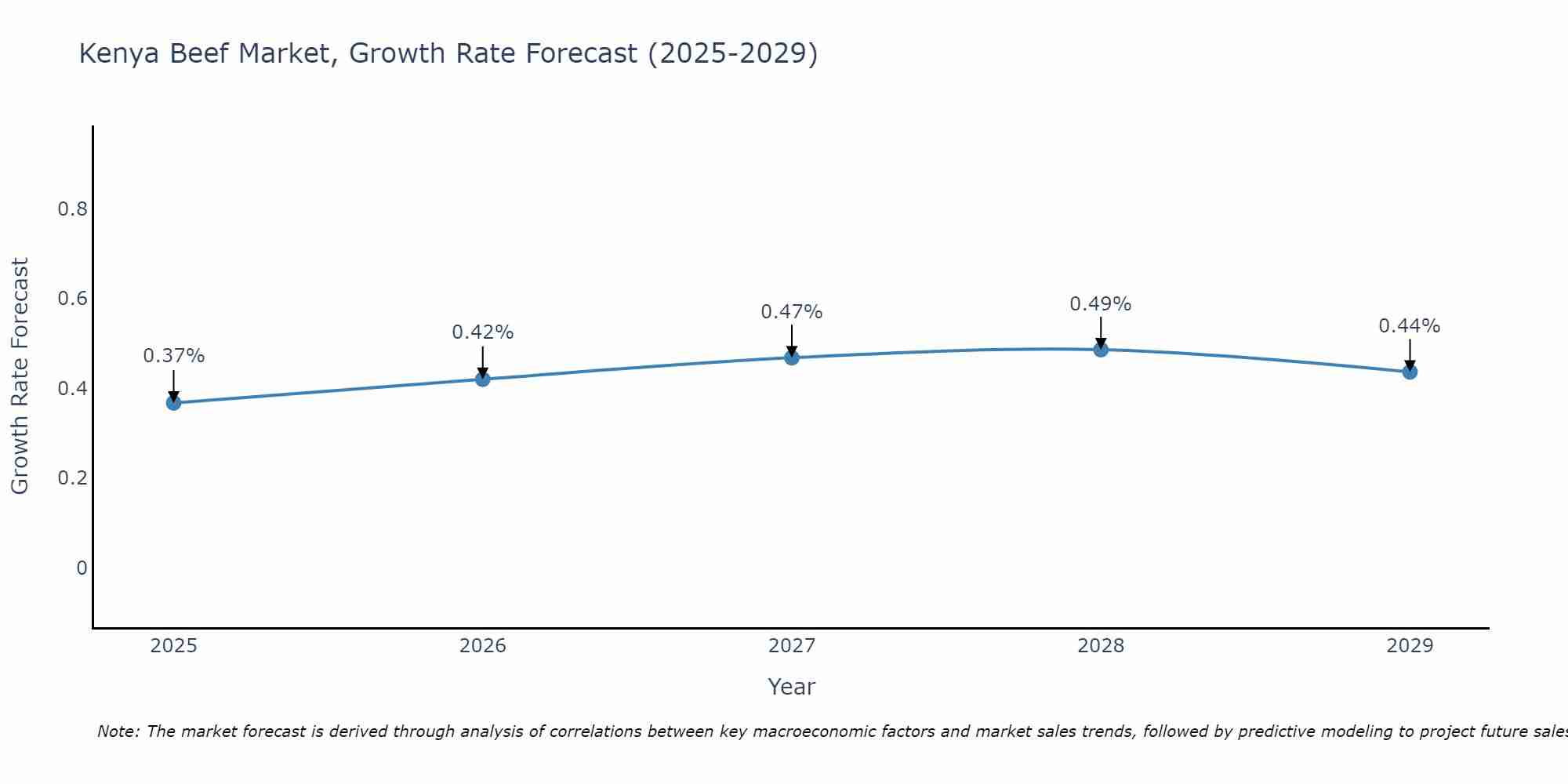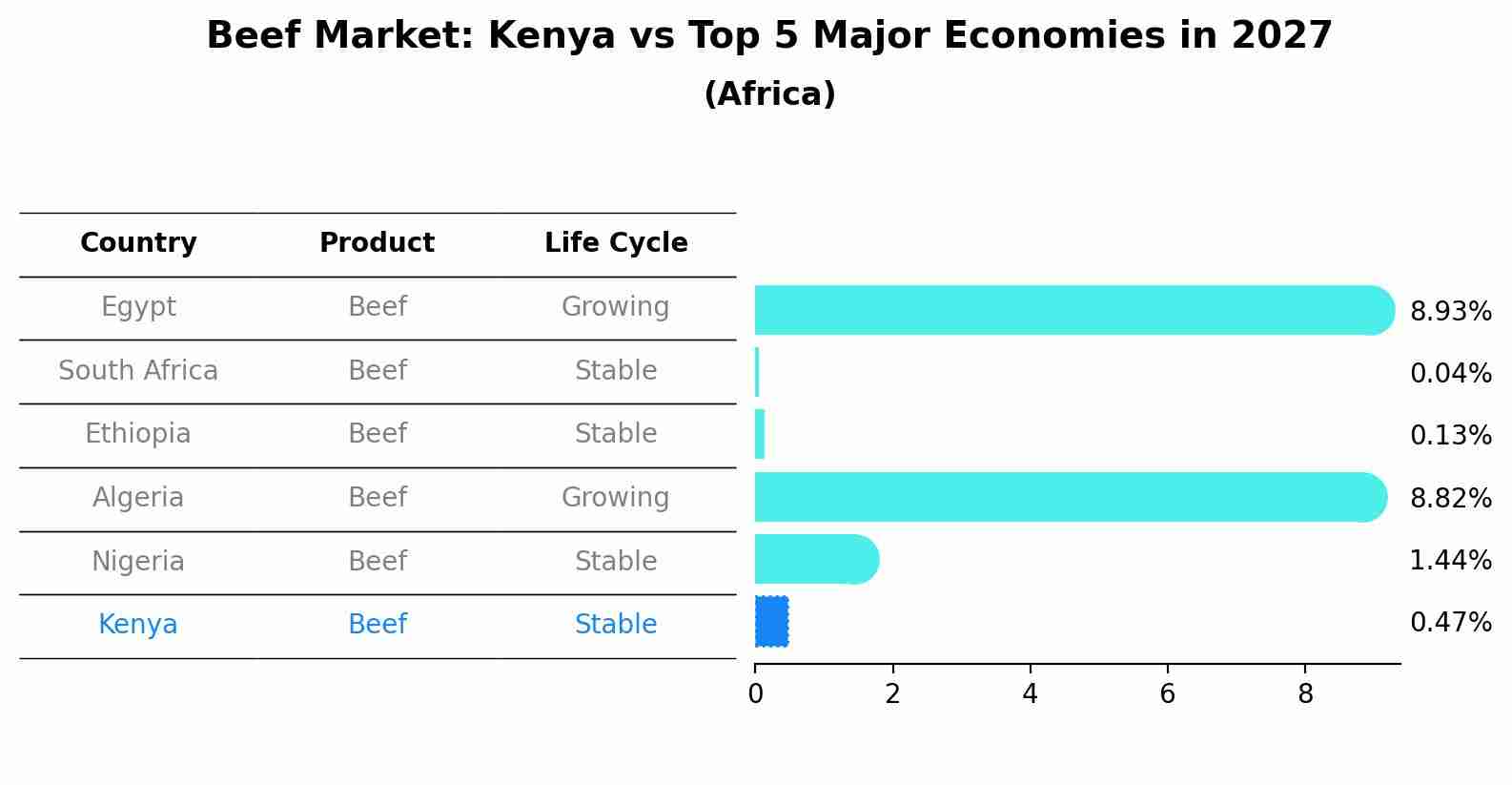Kenya Beef Market Outlook | Growth, Revenue, Share, Analysis, Value, Companies, Trends, COVID-19 IMPACT, Size, Forecast & Industry
| Product Code: ETC081489 | Publication Date: Jun 2021 | Updated Date: Jun 2025 | Product Type: Report | |
| Publisher: 6Wresearch | Author: Bhawna Singh | No. of Pages: 70 | No. of Figures: 35 | No. of Tables: 5 |
Kenya Beef Market Size Growth Rate
The Kenya Beef Market is projected to witness mixed growth rate patterns during 2025 to 2029. The growth rate begins at 0.37% in 2025, climbs to a high of 0.49% in 2028, and moderates to 0.44% by 2029.

Beef Market: Kenya vs Top 5 Major Economies in 2027 (Africa)
In the Africa region, the Beef market in Kenya is projected to expand at a stable growth rate of 0.47% by 2027. The largest economy is Egypt, followed by South Africa, Ethiopia, Algeria and Nigeria.

Kenya Beef Market Overview
The Kenya beef market is a significant sector within the country`s agricultural industry, driven by high consumer demand for beef products. The market is characterized by a mix of traditional practices and modern techniques, with a strong presence of both small-scale local producers and larger commercial farms. Beef consumption is a staple in Kenyan diets, with a preference for high-quality, lean cuts of meat. The market faces challenges such as inadequate infrastructure, limited access to markets for small-scale producers, and concerns over food safety and quality standards. However, there are opportunities for growth through improved value chain management, increased investments in technology and innovation, and expanding export markets. Overall, the Kenya beef market offers potential for expansion and development, driven by a growing population and changing consumer preferences.
Kenya Beef Market Trends
The Kenya beef market is experiencing several key trends. One significant trend is the growing demand for premium and organic beef products, driven by an increasing awareness among consumers about health and sustainability. This has led to a rise in specialty butcher shops and online platforms offering high-quality beef cuts. Another trend is the emphasis on food safety and quality standards, with consumers becoming more discerning about the origin and processing of the beef they purchase. Additionally, there is a shift towards convenience, with pre-packaged and ready-to-eat beef products gaining popularity. Overall, the Kenya beef market is evolving to meet the changing preferences of consumers towards healthier, higher-quality, and more convenient beef products.
Kenya Beef Market Challenges
In the Kenya Beef Market, challenges such as inadequate infrastructure, limited access to markets for small-scale producers, high production costs, and inconsistent quality standards pose significant obstacles. Poor road networks and limited cold storage facilities contribute to post-harvest losses, while small-scale farmers struggle to reach wider markets due to a lack of efficient distribution channels. Additionally, high input costs, including feeds and veterinary services, hinder profitability for producers. Quality control issues also arise, impacting consumer trust and export potential. Addressing these challenges will require investments in infrastructure, promotion of value chain efficiency, support for small-scale producers, and implementation of quality assurance mechanisms to enhance competitiveness and sustainability in the Kenya Beef Market.
Kenya Beef Market Investment Opportunities
The Kenya Beef Market presents promising investment opportunities due to increasing consumer demand for high-quality meat products, driven by a growing population and rising disposable incomes. Investors can consider opportunities in cattle farming, meat processing facilities, and retail outlets to capitalize on the expanding market. Additionally, there is potential for value-added products such as organic or grass-fed beef to cater to the health-conscious segment of consumers. Collaborating with local farmers to improve breeding practices and supply chain efficiency can also enhance profitability. With supportive government policies aimed at boosting the agricultural sector, investing in the Kenya Beef Market offers a lucrative avenue for growth and diversification within the food industry.
Kenya Beef Market Government Policy
The Kenyan government has implemented various policies to regulate and support the beef market in the country. These policies include the Livestock and Meat Act, which governs the production, processing, and marketing of beef to ensure quality and safety standards are met. Additionally, the government has established the Kenya Meat Commission to promote the meat industry and facilitate beef exports. The Ministry of Agriculture, Livestock, and Fisheries also provides support to small-scale farmers through initiatives such as the National Livestock Identification and Traceability System, which helps improve market access and ensure traceability of beef products. Overall, these policies aim to enhance the competitiveness of the Kenyan beef market, promote sustainable practices, and ensure consumer confidence in the quality of beef products.
Kenya Beef Market Future Outlook
The Kenya Beef Market is expected to experience steady growth in the coming years due to factors such as increasing population, rising disposable income, and changing dietary preferences towards protein-rich foods. The growing urbanization and expansion of the middle-class population are likely to drive the demand for beef products in Kenya. Additionally, the government`s initiatives to improve livestock farming practices and infrastructure are expected to further boost the market. However, challenges such as disease outbreaks, climate change impacts on grazing lands, and competition from alternative protein sources may pose some obstacles to the market`s growth. Overall, the Kenya Beef Market is projected to show positive growth prospects with opportunities for market players to innovate and cater to evolving consumer demands.
Key Highlights of the Report:
- Kenya Beef Market Outlook
- Market Size of Kenya Beef Market, 2021
- Forecast of Kenya Beef Market, 2027
- Historical Data and Forecast of Kenya Beef Revenues & Volume for the Period 2018 - 2027
- Kenya Beef Market Trend Evolution
- Kenya Beef Market Drivers and Challenges
- Kenya Beef Price Trends
- Kenya Beef Porter's Five Forces
- Kenya Beef Industry Life Cycle
- Historical Data and Forecast of Kenya Beef Market Revenues & Volume By Beef Cut for the Period 2018 - 2027
- Historical Data and Forecast of Kenya Beef Market Revenues & Volume By Brisket for the Period 2018 - 2027
- Historical Data and Forecast of Kenya Beef Market Revenues & Volume By Shank for the Period 2018 - 2027
- Historical Data and Forecast of Kenya Beef Market Revenues & Volume By Loin for the Period 2018 - 2027
- Historical Data and Forecast of Kenya Beef Market Revenues & Volume By Others for the Period 2018 - 2027
- Historical Data and Forecast of Kenya Beef Market Revenues & Volume By Beef Slaughter Method for the Period 2018 - 2027
- Historical Data and Forecast of Kenya Beef Market Revenues & Volume By Kosher for the Period 2018 - 2027
- Historical Data and Forecast of Kenya Beef Market Revenues & Volume By Halal for the Period 2018 - 2027
- Historical Data and Forecast of Kenya Beef Market Revenues & Volume By Others for the Period 2018 - 2027
- Kenya Beef Import Export Trade Statistics
- Market Opportunity Assessment By Beef Cut
- Market Opportunity Assessment By Beef Slaughter Method
- Kenya Beef Top Companies Market Share
- Kenya Beef Competitive Benchmarking By Technical and Operational Parameters
- Kenya Beef Company Profiles
- Kenya Beef Key Strategic Recommendations
Frequently Asked Questions About the Market Study (FAQs):
1 Executive Summary |
2 Introduction |
2.1 Key Highlights of the Report |
2.2 Report Description |
2.3 Market Scope & Segmentation |
2.4 Research Methodology |
2.5 Assumptions |
3 Kenya Beef Market Overview |
3.1 Kenya Country Macro Economic Indicators |
3.2 Kenya Beef Market Revenues & Volume, 2021 & 2027F |
3.3 Kenya Beef Market - Industry Life Cycle |
3.4 Kenya Beef Market - Porter's Five Forces |
3.5 Kenya Beef Market Revenues & Volume Share, By Beef Cut, 2021 & 2027F |
3.6 Kenya Beef Market Revenues & Volume Share, By Beef Slaughter Method, 2021 & 2027F |
4 Kenya Beef Market Dynamics |
4.1 Impact Analysis |
4.2 Market Drivers |
4.3 Market Restraints |
5 Kenya Beef Market Trends |
6 Kenya Beef Market, By Types |
6.1 Kenya Beef Market, By Beef Cut |
6.1.1 Overview and Analysis |
6.1.2 Kenya Beef Market Revenues & Volume, By Beef Cut, 2018 - 2027F |
6.1.3 Kenya Beef Market Revenues & Volume, By Brisket, 2018 - 2027F |
6.1.4 Kenya Beef Market Revenues & Volume, By Shank, 2018 - 2027F |
6.1.5 Kenya Beef Market Revenues & Volume, By Loin, 2018 - 2027F |
6.1.6 Kenya Beef Market Revenues & Volume, By Others, 2018 - 2027F |
6.2 Kenya Beef Market, By Beef Slaughter Method |
6.2.1 Overview and Analysis |
6.2.2 Kenya Beef Market Revenues & Volume, By Kosher, 2018 - 2027F |
6.2.3 Kenya Beef Market Revenues & Volume, By Halal, 2018 - 2027F |
6.2.4 Kenya Beef Market Revenues & Volume, By Others, 2018 - 2027F |
7 Kenya Beef Market Import-Export Trade Statistics |
7.1 Kenya Beef Market Export to Major Countries |
7.2 Kenya Beef Market Imports from Major Countries |
8 Kenya Beef Market Key Performance Indicators |
9 Kenya Beef Market - Opportunity Assessment |
9.1 Kenya Beef Market Opportunity Assessment, By Beef Cut, 2021 & 2027F |
9.2 Kenya Beef Market Opportunity Assessment, By Beef Slaughter Method, 2021 & 2027F |
10 Kenya Beef Market - Competitive Landscape |
10.1 Kenya Beef Market Revenue Share, By Companies, 2021 |
10.2 Kenya Beef Market Competitive Benchmarking, By Operating and Technical Parameters |
11 Company Profiles |
12 Recommendations |
13 Disclaimer |
- Single User License$ 1,995
- Department License$ 2,400
- Site License$ 3,120
- Global License$ 3,795
Search
Thought Leadership and Analyst Meet
Our Clients
Related Reports
- Afghanistan Apparel Market (2026-2032) | Growth, Outlook, Industry, Segmentation, Forecast, Size, Companies, Trends, Value, Share, Analysis & Revenue
- Canada Oil and Gas Market (2026-2032) | Share, Segmentation, Value, Industry, Trends, Forecast, Analysis, Size & Revenue, Growth, Competitive Landscape, Outlook, Companies
- Germany Breakfast Food Market (2026-2032) | Industry, Share, Growth, Size, Companies, Value, Analysis, Revenue, Trends, Forecast & Outlook
- Australia Briquette Market (2025-2031) | Growth, Size, Revenue, Forecast, Analysis, Trends, Value, Share, Industry & Companies
- Vietnam System Integrator Market (2025-2031) | Size, Companies, Analysis, Industry, Value, Forecast, Growth, Trends, Revenue & Share
- ASEAN and Thailand Brain Health Supplements Market (2025-2031) | Strategy, Consumer Insights, Analysis, Investment Trends, Opportunities, Growth, Size, Share, Industry, Revenue, Segments, Value, Segmentation, Supply, Forecast, Restraints, Outlook, Competition, Drivers, Trends, Demand, Pricing Analysis, Competitive, Strategic Insights, Companies, Challenges
- ASEAN Bearings Market (2025-2031) | Strategy, Consumer Insights, Analysis, Investment Trends, Opportunities, Growth, Size, Share, Industry, Revenue, Segments, Value, Segmentation, Supply, Forecast, Restraints, Outlook, Competition, Drivers, Trends, Demand, Pricing Analysis, Competitive, Strategic Insights, Companies, Challenges
- Europe Flooring Market (2025-2031) | Outlook, Share, Industry, Trends, Forecast, Companies, Revenue, Size, Analysis, Growth & Value
- Saudi Arabia Manlift Market (2025-2031) | Outlook, Size, Growth, Trends, Companies, Industry, Revenue, Value, Share, Forecast & Analysis
- Uganda Excavator, Crane, and Wheel Loaders Market (2025-2031) | Strategy, Consumer Insights, Analysis, Investment Trends, Opportunities, Growth, Size, Share, Industry, Revenue, Segments, Value, Segmentation, Supply, Forecast, Restraints, Outlook, Competition, Drivers, Trends, Demand, Pricing Analysis, Competitive, Strategic Insights, Companies, Challenges
Industry Events and Analyst Meet
Whitepaper
- Middle East & Africa Commercial Security Market Click here to view more.
- Middle East & Africa Fire Safety Systems & Equipment Market Click here to view more.
- GCC Drone Market Click here to view more.
- Middle East Lighting Fixture Market Click here to view more.
- GCC Physical & Perimeter Security Market Click here to view more.
6WResearch In News
- Doha a strategic location for EV manufacturing hub: IPA Qatar
- Demand for luxury TVs surging in the GCC, says Samsung
- Empowering Growth: The Thriving Journey of Bangladesh’s Cable Industry
- Demand for luxury TVs surging in the GCC, says Samsung
- Video call with a traditional healer? Once unthinkable, it’s now common in South Africa
- Intelligent Buildings To Smooth GCC’s Path To Net Zero


















